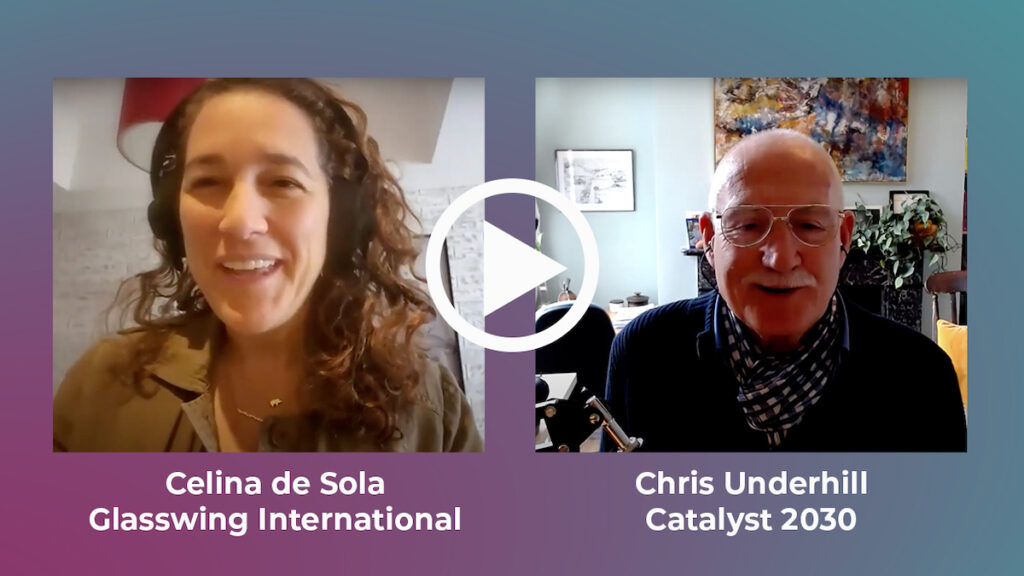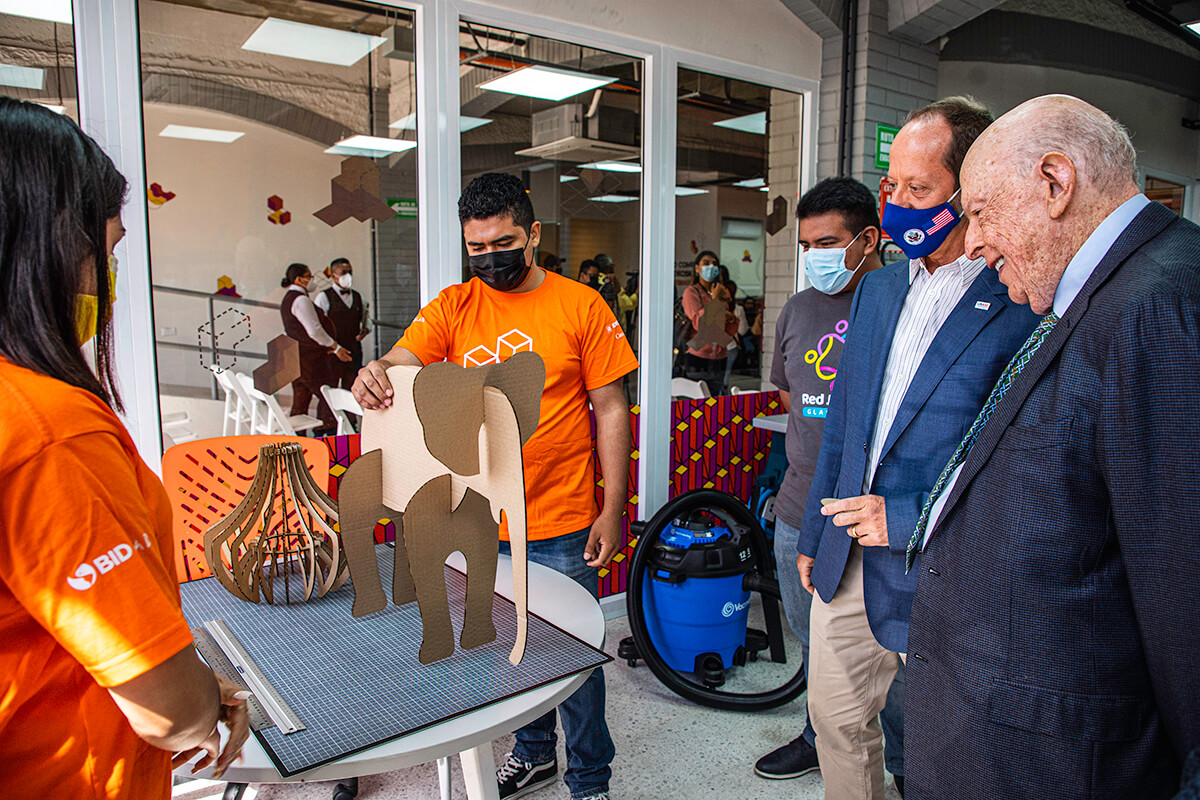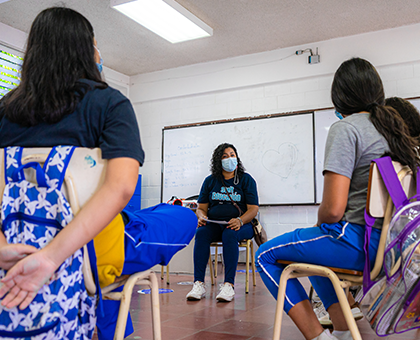Glasswing’s fourth annual Mental Health Conference
Published on July 17, 2024 by Glasswing
More than 400 attendees from 37 countries and approximately 20 panelists came together on May 30, 2024, for Glasswing’s fourth annual Mental Health Conference. The conference, in partnership with Catalyst 2030 and USAID, was an opportunity to explore the theme of “Scaling Mental Health and Bridging Innovations.”
Panelists shared expertise and experiences during six panels that spanned three tracks:
- Scaling Community Mental Health
- Mental Health and Climate Change
- Digital Solutions for Mental Health
Chris Underhill, chair of Catalyst 2030: Mental Health Collaboration, and Glasswing co-founder and president Celina de Sola provided opening and closing remarks. Chris discussed some recent developments in mental health, such as the expansion of workplace mental health; an increase in coalitions and organizations promoting global mental health; more considerations of mental health alongside different subjects, such as climate change or technology; and a focus on improved documentation and data collection.
Key insights from each panel are below, and conference videos are available for viewing on Glasswing’s YouTube page.
Track 1: Scaling Community Mental Health

Panel 1: Navigating Scale: Challenges and Evidence-Based Strategies for Impact in Rural Communities
The first panel took a close look at different models for building access to community mental health.
Samuel Habimana discussed the “Community Resilience Model” used by the Rwanda Resilience and Grounding Organization. This model, which was started by the Trauma Resource Institute, teaches individuals the ability to handle mental health stress. Groups of about 20-25 people meet with several trainers over the course of three days of intervention, during which they explore resilience, forgiveness, and reconsideration. Samuel spoke about applying the model in Rwanda, describing stigmas surrounding concepts of mental health and the persistence of mental health conditions following the 1994 genocide.
Joy Bittner, the co-founder of the Ecuador-based Vida Plena, explained that in “Interpersonal Group Therapy,” groups of about eight people meet over the course of two months to talk about causes and solutions. Lay community members are trained as group facilitators, an approach that reduces stigma and increases accessibility. Vida Plena practices cultural adaptation through local collaborations—such as with an Indigenous organization led by Quechua psychologists—and through implementation methods that align with local practices.
Peter Yaro of Basic Needs Ghana described the rights-based “Model for Mental Health and Development,” which situates mental health, as he explained, “within development, within poverty reduction, within livelihoods, within rights to participate” and inclusion. The model addresses health and socioeconomic needs and maximizes community resources for access to quality health care services. Basic Needs Ghana has reached nearly two million people.
Peter spoke of the importance of working within the existing system to improve it. He would hear comments like, “‘We are more concerned about communicable diseases. Malaria is still a challenge. We have issues of cholera and the rest. Why bother us with mental health?’” He said, “We were able to demonstrate from the work we do that not only is there a need for mental health care services because many people are experiencing common conditions that impact their day-to-day lives, but also that simple steps mobilizing community resources and involving families in the treatment and management of mental health conditions do not require so much capital.” Instead, it is “cost-effective, community-oriented, [and] very easily adaptable.”
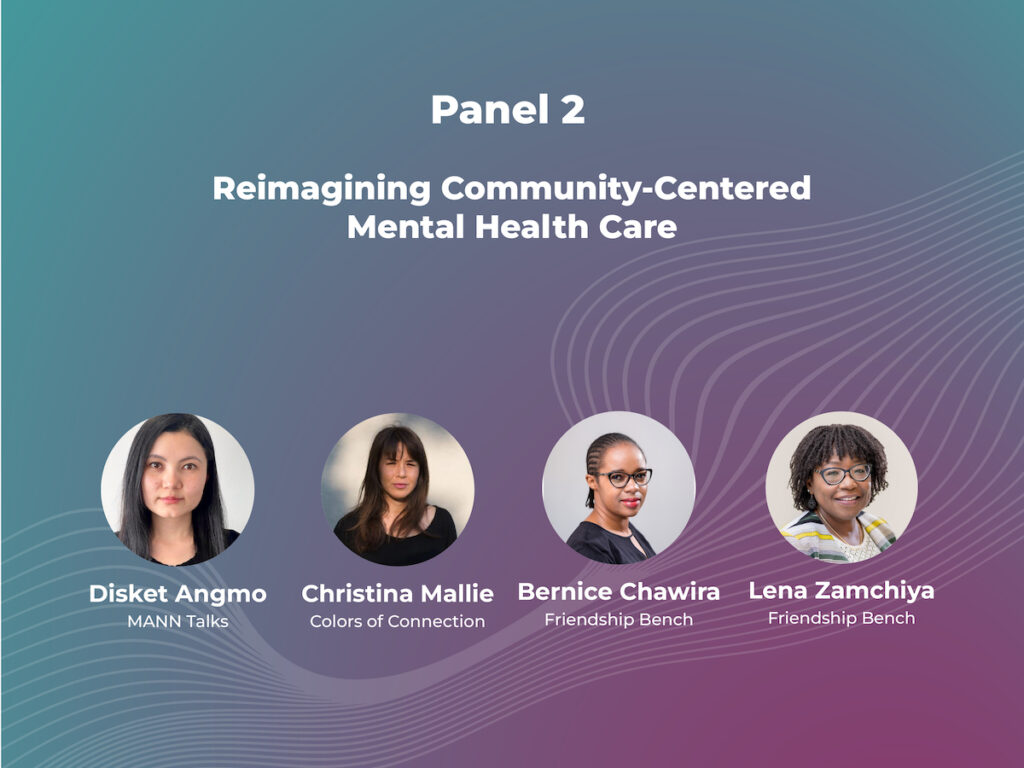
Panel 2: Reimagining Community-Centered Mental Health Care
During Panel 1, Peter Yaro spoke of “reach[ing] out for the unreached.” Panel 2 also examined this objective, with panelists sharing what their organizations do to achieve it.
Lena Zamchiya and Bernice Chawira described how The Friendship Bench uses a no-cost intervention to help people with mental health conditions such as anxiety and depression. The Friendship Bench, which is based in Zimbabwe, trains community volunteers to serve as lay health workers and deliver interventions. The volunteers are Grandmothers, who are highly respected in their communities. As Lena noted, “Culture becomes key in terms of recognizing that the Grandmother is symbolic, to be able to assist in addressing issues around mental health.”
Another way in which culture is integral to The Friendship Bench’s approach is in the use of the vernacular, such as the Shona words “kufungisisa” (“overthinking”) and “kuvhura pfungwa” (“opening up the mind”). Using local terminology demystifies mental health and allows for the spread of interventions.
Disket Angmo described the work that MANN Talks does to serve marginalized communities in India through a tele-help line, free email counseling support, and appointment-based therapy. MANN Talks creates spaces to talk about the most vulnerable of topics, while working to reduce both the treatment and care gap and the stigmas around mental health.
Disket explained that one of their priorities is to deliver contextualized interventions. “India is extremely diverse when it comes to culture, when it comes to language, when it comes to religion, food. … It’s important to understand the cultural context of every client that reaches out to us and invest time in understanding where they come from, the way they’ve grown up, and to truly understand their local context before going ahead with mental health interventions.”
Christina Mallie of Colors of Connection explained how, in areas impacted by violence, community-based art projects and arts-based mental health interventions help to mitigate the impacts of trauma for young people. Colors of Connection works with girls ages 10 to 14 in the eastern Democratic Republic of the Congo, supporting social and emotional health, establishing safe spaces, and providing mentorship and foundational life skills amid opportunities for creative activities.
“Creativity supports the ability to imagine different futures and identities beyond restrictive gender roles, which is hugely important for girls who are in this environment where their social position is highly restricted,” Christina said. “Creativity has been found to be able to resuscitate the imaginative capacities when there is trauma and damage from trauma.”
Track 2: Mental Health and Climate Change
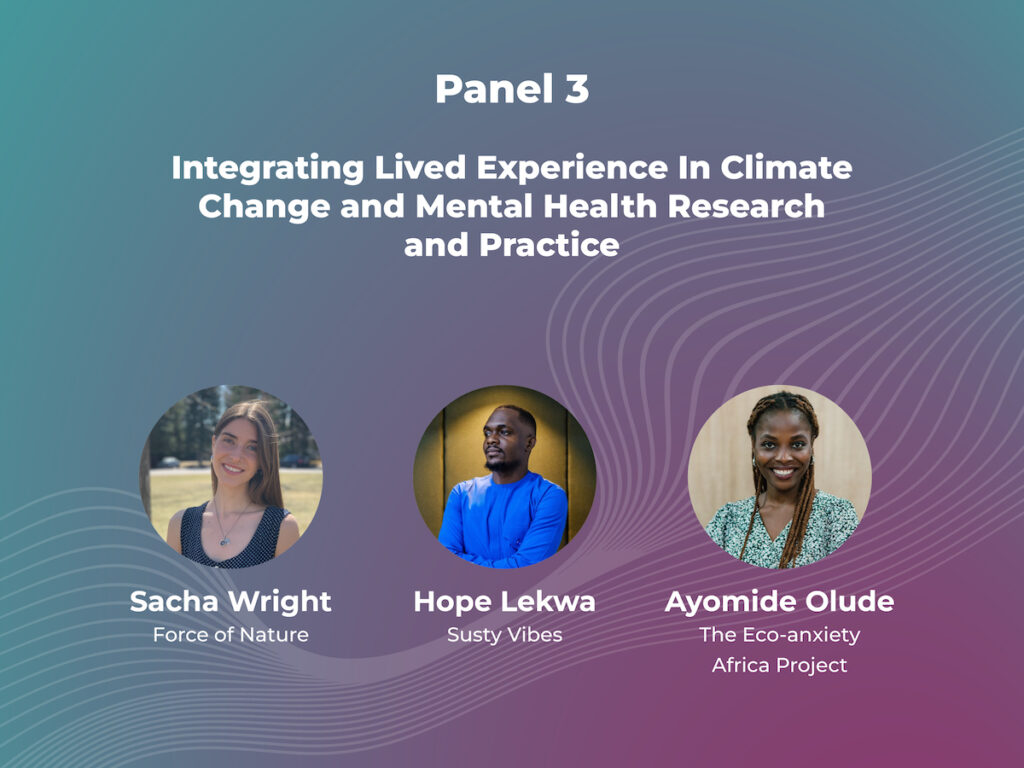
Panel 3: Integrating Lived Experience in Climate Change and Mental Health Research and Practice
The third panel brought together Ayomide Olude and Hope Lekwa of SustyVibes, Sacha Wright of Force of Nature, and Lian Zeitz of the Climate Mental Health Network, who moderated the discussion. The panelists had previously worked together on a global project called “Connecting Climate Minds,” which studied the lived experience (LE) of mental health for those affected by climate change.
As Sacha noted, much of the discussion around climate change looks at aspects that seem removed from our daily lives: melting ice caps, degrees of carbon. Having conversations around mental health and climate change means homing in on the human experience and the impacts on people and their families, such as feelings of grief, powerlessness, motivation, and so forth.
The project defined “lived experience” as “the unique forms of person-centred and communal knowledge, insight, stories, and expertise that come from a range of experiences.” It showcased first-hand accounts and stories. “Meaningfully engaging with people” and “ask[ing] for their input … is key to changing systems,” Ayomide said.
“Lived experience can’t just be seen as something separate or siloed from the main project itself,” Sacha said. “If you have an entire body of academic outputs, and then you put lived experience at a separate table, treat it like a kids’ table, then it will only ever be used tokenistically.” She described the limitations of “research that has just been done for research’s sake, interventions and solutions that have been implemented, only to fall flat after coming into contact with messy realities in people’s lives.”
“If solutions are going to be identified for people, then they need to be identified by the people who will be using them and who will be benefiting from them,” Sacha said.
Hope shared some of the practical aspects and concerns surrounding implementation, including:
- Data security to safeguard people’s stories
- Different understandings of “mental health,” “climate change,” and other terminology
- Flexible approaches that accommodated participants’ needs (for instance, they could text if they preferred to write instead of talk)
- Trust building, to convey to participants that their input would be used for global research and to inform policy, not for exploitation
The group produced “Deepening Research and Practice: A Lived Experience Toolkit by Connecting Climate Minds,” a toolkit to help guide researchers and practitioners who are seeking to engage lived experience in their work on climate change and mental health.

Panel 4: Trauma and Collective Healing
How can collective healing pave the way for systems change? That was one of the questions considered during Panel 4, a conversation between experts from the Collective Change Lab: Laura Calderón de la Barca, Juanita Zerda, and moderator Tad Khosa.
The group discussed viewing trauma through a “systems lens.” As Laura, Katherine Milligan, and John Kania from Collective Change Lab wrote in an article earlier this year in Stanford Social Innovation Review:
“Seeing trauma through a systems lens shines a light on an obvious truth: The collective dimension of trauma requires a collective context for healing. In much of the Western world, there’s an assumption that trauma healing should happen individually and in private, such as in a psychologist’s office. And while therapy is absolutely appropriate in some circumstances, it’s insufficient for healing from collective wounds.” [emphasis added]
The panelists explored “how recognizing trauma in ourselves, other people, and the systems around us can open up new pathways to solving social problems.”
“Something important I’ve learned is that I suffer alone but heal in community,” Juanita said. She reflected on her experiences growing up in Colombia in the 1990s, and how her past shapes her responses today, including a lingering expectation that she will have to defend herself. Convivencia—learning to live and be with each other—helps with healing by allowing us to “see our common humanity.”
That could mean being together physically in settings such as circles work. These are facilitated conversations during which people sit in a circle and speak their truths. “It’s not about convincing each other,” Juanita said. “It’s about witnessing each other. Sometimes we just have to be.”
Tad, who grew up in South Africa during the 1990s, considered the historical traumas of colonialism and apartheid and their impacts today for Black South Africans, from an atmosphere of fear to disparities in housing, health care, and economic inclusion. The traumas include the suppression of culture—language and traditions—resulting in a constant feeling of being under threat.
“To heal, we need to recognize that we do carry a wound,” Laura said. “May all this pain not be in vain.”
Track 3: Digital Solutions for Mental Health

Panel 5: Addressing Barriers in AI for Mental Health Equity
Panel 5 considered the role of artificial intelligence and other technologies in the mental health ecosystem, including both the challenges that technologies introduce and the solutions to address some of those challenges. The conversation was moderated by Maura Reap of USAID and joined by Christie Civetta of Dimagi, Pauline Keronyai of Nama Wellness, Rhea Yadav of Wysa, and Dena Trujillo of Crisis Text Line.
The challenges discussed included the needs for:
- Cultural adaptation. Pauline, whose work is based in Uganda, emphasized the importance of adapting to cultural norms and beliefs. She gave an example of a woman in a community where women don’t typically possess their own money. If the woman were to own a smartphone, others, including her own family members, might judge her negatively.
- Data security. Christie considered the question of informed consent, particularly with a topic as complex as data. For example, she asked, “How do you explain things like the cloud?” She emphasized how crucial it is not just to protect people’s data, but to help them understand what happens with it.
- Contextualization. “When it comes to marginalized communities, contextualization is high stakes,” Rhea said. Wysa’s chatbot, which is built on AI models and grounded in cognitive behavioral therapy, uses safeguards to identify if someone is at high risk. Crisis Text Line—a text-based mental health support and crisis intervention tool—does the same, Dena said.
To address those challenges, panelists shared solutions such as:
- Engaging community right from the start, which Pauline’s team does through measures and practices such as community approvals.
- To ensure that people’s data is protected, Dena advocated for education around bias and empathy, and Pauline expressed the need for a data protection policy.
The conversation was enhanced by thoughtful questions posed in the chat. One attendee asked, “If screen time and less physical human connection are a possible source of poor mental health outcomes, how do we be sure we use AI and devices [in ways that] are not encouraging less human connection?”
Rhea responded, “It’s imperative that digital solutions design interventions in a way that are non addictive, non exploitative on psychological impulses, and do not create dependencies.”
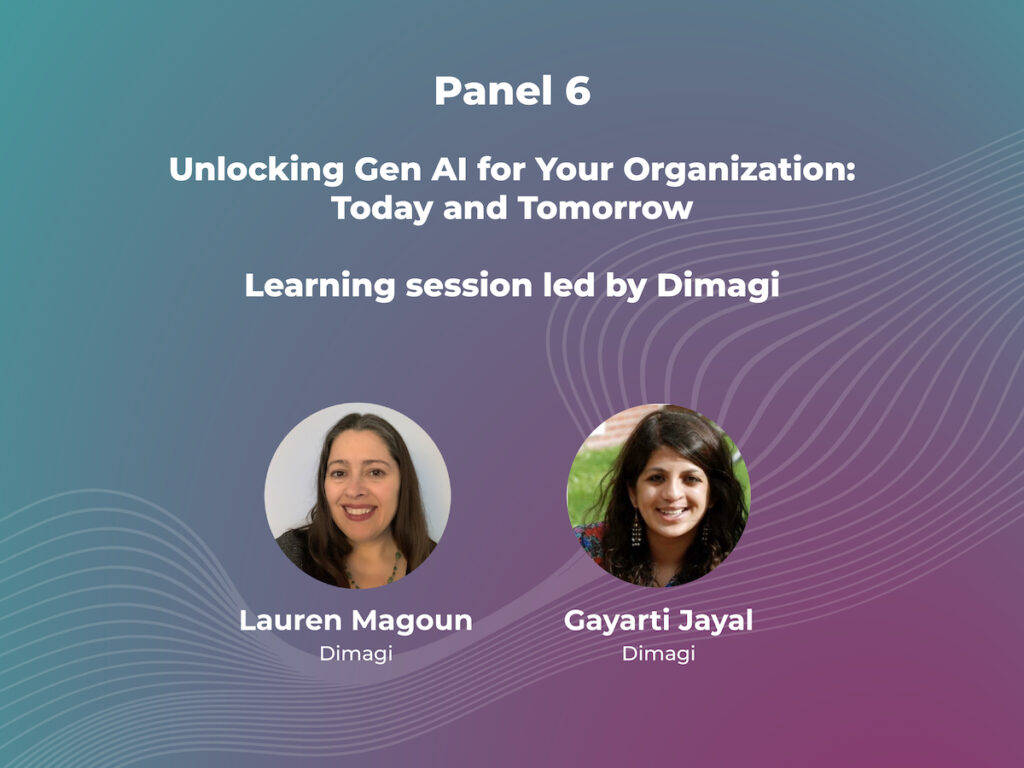
Panel 6: Unlocking Gen AI for Your Organization: Today and Tomorrow
The final panel of the conference took a different approach, with Lauren Magoun and Gayatri Jayal of Dimagi presenting a learning session on using generative AI to achieve organizational impact. Dimagi builds digital tools for frontline workers and frontline worker aid, so they can deliver critical health services and bridge the gap in access to health care.
The conversation explored how to use AI to support global mental health programs and gave tips for integrating AI no matter your organization’s level of experience with it. Lauren and Gayatri shared an example of how to build a chatbot, as well as use cases for chatbots and community-based mental health care.
Among the topics they considered was cultural sensitivity, as large-language models like ChatGPT aren’t tailored to specific cultures and regions. ChatGPT, they explained, is just one chatbot. “The more chatbots are tried and tested in specific contexts, the more feedback we can gather to update the prompt for that bot,” Gayatri said. “We can safeguard against cultural deviation by specifying in the prompt: 1) where the chatbot is being deployed and 2) any general high level cultural or social associations—with the topic of the bot—or even very specific terms the chatbot should and should not use.”
Glasswing and Mental Health
The Mental Health Conference occurred toward the end of Mental Health Awareness Month. During the month, Glasswing also launched several initiatives to highlight the importance of mental health awareness and access, including:
- Rincones de la Calma, a partnership with the Con Cora Foundation, founded by global artist Karol G
- The SanaMente Podcast, featuring conversations with mental health experts
- Pathways for Healing, a campaign to promote conversations about mental health and well-being
Each of these initiatives is founded on the principle that everyone, everywhere deserves access to effective mental health care. Through SanaMente and other Glasswing mental health programs, we strive toward a vision of true mental health equity.

